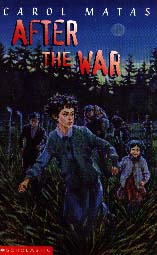


|
After the War.
Carol Matas.
Subject Headings:
Grades 6 - 9 / Ages 11 - 14.
**** /4
|

excerpt:
The trip to Klodzko is uneventful. We get the children off at the station and are met by a British driver who hurries us onto a truck, headed for Kudowa. It is a beuatiful summer day. The sky is blue, the hills and forests are deep green splashed with flowers. There is some beauty in the world, I think to myself, if only in nature, certainly not in people. Although I am impressed by how smoothly these Brichah workers have everything going so far. We reach Kudowa near dusk. The Mossad operator who drives the truck points the way to us, across the border, assuring us someone will be there to meet us if we make it through. We line the children up in two, always an older child escorting a younger one. There are a couple of girls my age, I think, a couple of boys too, but I don't let on for a minute that I should be in the group and not leading it.It is dusk when we lead the children through a path in the forest to an open meadow. There, past the high grass, over the right, we can see the frontier; two posts about 100 yards from each other, each manned by soldiers.
The award-winning novel After the War tells the story of Ruth Mendenberg, a Polish teenager, who has survived World War II in Auschwitz only to return to her home to find it occupied by her German servant. Ruth, 15, begins to search for any remaining family in the town's city hall where she has little success, but she does meet up with a Jewish underground organization that smuggles illegal immigrants into Palestine. Because she has no home or family, Ruth joins a group of children who are being smuggled through Europe in the hope that Britain will allow them into Palestine. The story is based on actual events that occurred between 1946-49 during the struggle for a Jewish homeland.
The story tells of the group's journey from country to country as they are sometimes helped and other times hindered in their travels. The group does not know whom to trust or, at times, where to turn. When they finally reach Italy and are put on a boat for Palestine, Ruth finds her brother Simon. An informative sidelight involves the various political groups that court the Jewish refugees. Simon becomes part of the Betar and later the Irgun, an Orthodox militant faction, whereas Ruth joins the Haganah, a group that will fight only for defense and will not initiate aggression.
Interspersed throughout the novel are Ruth's memories of her earlier years, the happy family times, and the period in the concentration camp. The memories appear in a different font and appear less and less as the novel progresses and Ruth is forced to come to grips with her past. Her journey with the children helps her to face her demons as she is instructed to listen to their stories. It is in the telling of their stories that they can accept the past and face the future. The novel's hopeful nature implies that there is strength and beauty in human nature which is hidden in deep places but which, for lasting survival, must surface. The novel ends with the arrival at the kibbutz in Israel of Ruth and her companions.
After the War is highly recommended as a reading choice for the middle years. It adds a detailed understanding of the period immediately after the Second World War and the difficulties faced by those who survived the conflict's horrors.
Highly recommended.
Deborah Mervold is a teacher-librarian in a grade 6-12 school and a grade 12 English teacher at Shellbrook Composite High School in Saskatchewan.

To comment on this title or this review, send mail to cm@umanitoba.ca.
Copyright © 1998 the Manitoba Library Association. Reproduction for personal use is permitted only if this copyright notice is maintained. Any other reproduction is prohibited without permission.
Published by
The Manitoba Library Association
ISSN 1201-9364
TABLE OF CONTENTS FOR THIS ISSUE - FEBRUARY 13, 1998.
AUTHORS | TITLES | MEDIA REVIEWS | BOOKSHELF | BACK ISSUES | SEARCH | CMARCHIVE | HOME